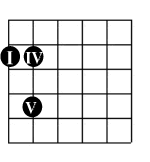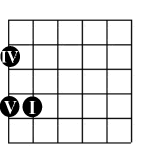The 12-bar blues is one of the most popular chord progressions in popular music, including the blues. The blues progression has a distinctive form in chord structure and duration. It is, at its most basic, based on the I-IV-V chords of a key.
The 12 bar blues progression is the foundation of the blues. The whole blues genre is very minimalistic. Basically, all you need to get started is to learn the 12 bar blues progression and The Most Commonly Used Lead Pattern.
There are two common variations of the 12 bar blues progression. We’ll use Roman numerals to indicate each chord’s relationship to the key.
The “I” chord is the first chord in the key, “IV” is the fourth chord in the key, and “V” is the fifth chord in the key.
Or for now, you can just use the diagrams below to find them. They can appear on any fret up and down the fretboard to play in different keys.

OR:

These 3 chords are the most important chords in almost any genre, not just the blues. Usually without the heavy use of these 3 chords a song will lose its sense of key-which is bad news in almost any genre of music.
Many genre-including the blues-use these 3 chords on an exclusive basis. Ever heard someone poke fun at garage bands that only know 3 chords or 3 chord rock songs? Well, these 3 chords are the ones they are talking about.
Now on to the actual 12 bar blues progression. The brackets will indicate a measure (or bar) and the roman numeral tells you which chord (the 1st, 4th, or 5th chord in the key). The last two bars of the progression are called the “turnaround” that leads us back to the beginning. Things to do during turnarounds are a whole separate topic unto themselves.
[I][I][I][I][IV][IV][I][I][V][IV][I][I,IV,V]
Below is the “quick change” variation. The only difference is the substitution of the IV chord in the second measure.
[I][IV][I][I][IV][IV][I][I][V][IV][I][I,IV,V]
Now, how the heck do we determine what chords to play. If we were playing in the key of A we could locate the A on the 5th fret of the low E string which is the I chord. Using the first diagram above we would know that the IV chord is D and the V chord is E.
If it was the key of A minor instead of A it would be Am, Dm, Em instead. Simple, eh?
Okay, what about 7th chords, 9th chords, and so on? Remember that these fancy chords are only major or minor chords with added notes. So, technically you can throw in one of these chords in substitution of a regular major or minor chord. Just use the right one. Don’t throw in a minor chord variation in substitution of a major chord.
For example, our A major key song we could use A7, D7, E7 or A9, D9, E9, and our A minor song we could use Am7, Dm7, Em7, and so on.